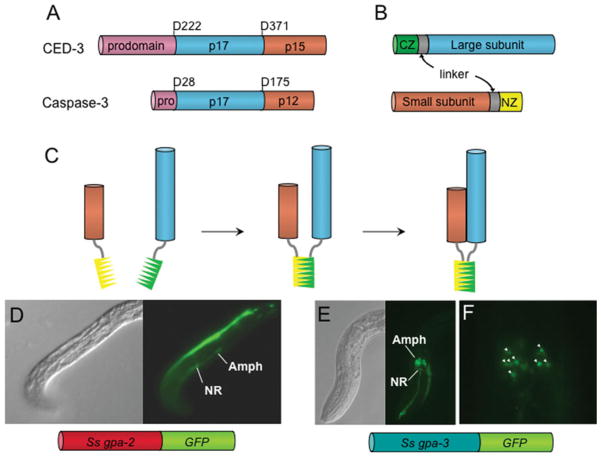Fig. 2.
Cell ablation by expression of reconstituted caspases: a potential application of transgenesis in Strongyloides sp. A. Schematics of the C. elegans CED-3 and caspase-3 procaspases showing prodomains (pink), large subunits (blue) and small subunits (orange). B. Expression constructs encoding the large and small subunits of a caspase fused to one of two antiparallel leucine zipper domains (CZ, green; NZ, yellow) and an intervening linker sequence (gray). These would be expressed under separate promoters with multi-cell specificities that overlapped in a single cell or cell type. C. In the single cells where the subunit constructs were co-expressed, the complementary leucine-zippers would bind, bringing the large and small subunits into proximity, reconstituting the active caspase and destroying the cell. D – F depict expression of neuron-specific reporter constructs in apparently overlapping subsets of amphidial neurons in transgenic S. stercoralis. D. DIC (left) and fluorescence images (right) of an F1 transgenic first-stage larva expressing GFP under the promoter of the Gα protein-encoding gene Ss-gpa-2. Note that a single amphidial neuron, which we hypothesize is ASK, expresses the reporter. The cell body of this neuron, labeled ‘Amph’, and its dendritic process track along the lower margin of the worm, posterior to the nerve ring (NR) in this image. E. DIC (left) and fluorescence images (right) of an F1 transgenic first-stage larva expressing GFP under the promoter of the Gα protein-encoding gene Ss-gpa-3 (Amph – amphidial cell bodies; NR – nerve ring). F. High-magnification fluorescence image of amphidial cell bodies (arrow heads) expressing GFP under the Ss-gpa-3 promoter. Note that up to eight amphidial neurons express the construct and that based on comparison to C. elegans we hypothesize that these include ASK. Promoters with these cell specificities would theoretically allow ablation of ASK-class neurons by transgene-based expression of reconstituted caspases. Panels A–C are redrawn from Chelur, D. S. and Chalfie, M. (2007). Targeted cell killing by reconstituted caspases. Proceedings of the National Academy of Sciences of the United States of America, 104, 2283–2288, Copyright (2007) National Academy of Sciences, U.S.A., with permission.

